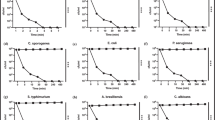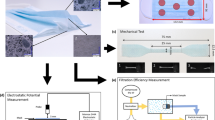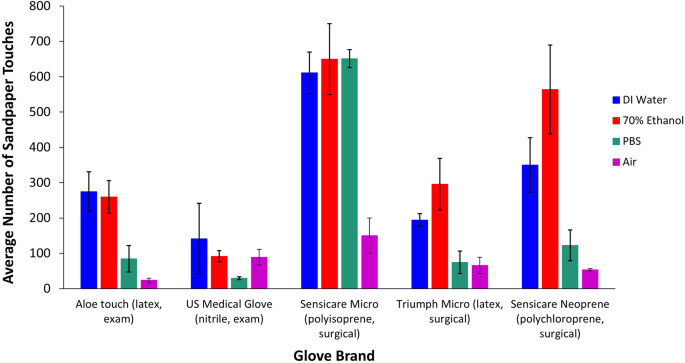Abstract
Background
Medical professionals are constantly exposed to bodily fluids and sanitizing agents during routine medical procedures. Unbeknownst to many healthcare workers, however, the barrier integrity of medical gloves can be altered when exposed to these substances, potentially resulting in exposure to dangerous pathogens.
Methods
This experimental study was designed to test the hypothesis that the durability of both natural and synthetic solvent-exposed medical gloves will be lower than the durability of the gloves in air. The testing consisted of a sample of commercially available medical gloves exposed to 70% ethanol, phosphate buffered saline, and deionized water, aimed at simulating the environments in which medical gloves are commonly worn. Gloves were included in this study based on their performance in previous durability studies in air. Data were collected over a period of three months. The glove assessment device automatically detects pinhole-sized perforations in medical gloves, eliminating the need to visually inspect each glove. Relative durability was measured as the average number of sandpaper touches until glove puncture.
Results
Four out of five glove brands performed better when exposed to all three solvents than in air, which is likely due to slippage in the interface between the wet glove and the sandpaper. Sensicare Micro, a polyisoprene surgical glove, had the most consistent durability in all three solvents tested. A two-way ANOVA revealed that both glove brand (P = 0.0001), solvent (P = 0.0001), and their interaction (P = 0.0040, α = 0.05) significantly affected average glove durability.
Conclusions
Glove durability did not remain consistent in 70% ethanol, phosphate buffered saline, deionized water, and air. These results make it clear that additional testing and labeling information would help healthcare workers select gloves for use in specific environments to ensure the best barrier protection against disease or toxins.
Similar content being viewed by others
Introduction
The critical role of medical gloves in disease prevention was highlighted during the COVID-19 pandemic when the demand for these essential protective items doubled in the United States, leading to widespread shortages [1]. Previous studies have shown that glove durability varies greatly depending on glove material, type, thickness, usage time, and manufacturer, and that substandard gloves put the health of safety of healthcare workers and patients at risk [1,2,3,4,5].
To ensure the barrier of their gloves remains intact throughout lengthy medical procedures, surgeons commonly wear two layers of gloves, as doing so reduces the number of perforations by up to 71% compared to the use of a single pair of gloves [6]. In addition, one study found that double-gloved latex surgical gloves contained no perforations after being subjected to high-friction two-handed knot tying techniques [7]. However, these studies do not account for the fluids that medical professionals frequently encounter, such as saliva, blood, and disinfectants, that have the potential to alter the physical properties of their medical gloves and, the authors hypothesize, reduce their effectiveness as protective barriers [8].
The mechanical properties of medical gloves have been demonstrated to change depending on solvent exposure. A study on the durability of natural and synthetic medical gloves that had been exposed to phosphate buffered saline (PBS), ethanol, and air concluded that relative glove performance depended upon the solvent (if any) in which the glove had been submerged [9]. The order of failure for solvent-exposed gloves does not necessarily match the failure order of dry gloves [2, 9]. Another study demonstrated that the application of alcohol-based hand rubs to nitrile and latex examination gloves resulted in decreased tensile strength and increased ultimate elongation, particularly of the nitrile samples [10].
The objective of this study was to utilize an automated glove assessment device [11] to determine the relative durability of natural and synthetic medical gloves exposed to common medical solvents in order to simulate glove use in realistic environments.
Materials and methods
Gloves
The gloves selected for this study were chosen because they had been previously demonstrated to have superior durability in dry conditions [2]. Synthetic gloves included U.S. Medical Glove (nitrile examination gloves), Montgomery, IL, USA, Sensicare Neoprene (polychloroprene surgical gloves; Medline), Northfield, IL, USA, and Sensicare Micro (polyisoprene surgical gloves; Medline), Northfield, IL, USA. The natural latex gloves included Triumph Micro (latex surgical gloves; Medline), Northfield, IL, USA and Aloe Touch (latex examination gloves; Medline), Northfield, IL, USA. Glove sizes were selected to fit securely on the prosthetic hand of the Glove Assessment Device (GAD), namely, sizes medium and large or numerical sizes 6–8. Five trials were conducted for each sample/solvent combination with the exception of Sensicare Micro polyisoprene surgical gloves tested in PBS, which had four trials only due to one defective glove. Thicknesses were an average of three measurements taken at the middle finger of the glove.
Glove Assessment device (GAD)
The Glove Assessment Device (GAD) that was used to determine relative glove durability eliminates the need to manually inspect gloves for holes, or perform a water leak test, because it relies on a vacuum within the base of a prosthetic hand, which creates a seal when a glove is donned [11]. The two middle fingers of the hand are porous, allowing airflow into the base of the hand only when a puncture occurs in the glove. A pressure sensor causes the GAD to automatically cease operation when a pressure spike occurs due to a perforation in the glove. To induce a perforation, the GAD uses a strip of 120-grit waterproof sandpaper clamped onto a mobile drum that touches the fingertips of the prosthetic hand repeatedly at a set force. The sandpaper was replaced for each new glove tested. The liquid spray functionality of the GAD was used to simulate medical environments more realistically. All settings on the GAD were set to default [11] apart from the sprayer, which was set to spray the glove fingers once between each touch of the sandpaper drum. Data were collected over a period of three months.
Solvents
The selected solvents were deionized water, phosphate buffered saline (PBS solution, Fisher Scientific, Pittsburgh, PA, USA), and 70% ethanol solution (Fisher Scientific, Pittsburgh, PA, USA). PBS closely mimics properties of human bodily fluids, including ion concentration, osmolarity, and pH. Ethanol is commonly used as a cleaning agent and disinfectant in medical facilities. DI water was used as a reference liquid and was also used to cleanse the tubing of the GAD when changing solvents.
Statistical analysis
The software JMP 16 was used for all statistical analyses in this study. These analyses included a two-way analysis of variance and Tukey-Kramer HSD tests. The two independent variables tested were glove type and solvent, and the independent variable was the average number of sandpaper touches until glove failure.
Results
Glove durability differed drastically depending on the type of solvent to which the glove was exposed, with the exception of Sensicare Micro brand polyisoprene surgical gloves which had a consistent performance in all three solvents (Fig. 1). Gloves exposed to solvents of any kind generally were more durable than gloves tested in air (Fig. 1). Most surgical gloves performed better than exam gloves in all three solvents; however, the Aloe Touch brand natural latex exam gloves had very similar durability to the Triumph Micro latex surgical gloves (Fig. 1). This result indicates that material plays an important role in solvent-exposed glove durability, regardless of glove usage type (surgical or exam). The U.S. Medical Glove brand nitrile exam glove was also the only glove to perform better in air than in one of the solvents, in this case PBS (Fig. 1).
The two-way ANOVA revealed that at least one factor was significant (P = 0.0001). The subsequent effects test showed that glove type (P = 0.0001), solvent (P = 0.0001), and their interaction (P = 0.0040) all significantly affected durability (average number of sandpaper touches to failure). The Sensicare Micro polyisoprene surgical glove lasted significantly longer than the other gloves under testing (Tukey’s HSD test, Table 1). Gloves tested in PBS and air had significantly different average number of touches than the other two test treatments (Table 2). The connecting letters report for the cross effect of glove type and solvent revealed that no singular glove/solvent combination resulted in a significantly different least square mean from all other combinations (Table 3).
Surgical gloves are usually thicker than examination gloves and have higher mechanical performance requirements than exam gloves (ASTM D3578-19 and D3577-19) and so are expected to have greater durability [12, 13]. However, although Sensicare Neoprene brand polychloroprene surgical gloves were the thickest gloves out of those tested, they were the second least durable in air and were less durable than the Sensicare Micro brand polyisoprene surgical gloves in all solvents (Fig. 2).
Sensicare Micro (polyisoprene, surgical) and Sensicare Neoprene (polychloroprene, surgical) brand gloves were of similar thickness, but had drastically different durability under most testing conditions (Fig. 2). Similarly, U.S. Medical Glove brand nitrile exam gloves and Aloe Touch brand latex exam gloves were the same thickness but did not have similar durability.
Discussion
Average glove durability was generally lower in air than in any of the solvents tested. The likeliest explanation for this phenomenon is the presence of slippage within the sandpaper/glove interface when liquids are introduced. The solvents likely acted as lubricants, lessening the interaction of the abrasive sandpaper with the glove film.
ASTM International provides specific standards which all examination gloves (D3578-19) and surgical gloves (D3577-19) must meet, regardless of whether they are made of natural (Type I) or synthetic (Type II) polymers [12, 13]. Because the sampled gloves have previously been confirmed to meet these standards, substandard glove quality can be ruled out as a cause of durability differences [2].
The large variation in durability observed between gloves of similar thickness indicates that the composition of the glove, and not solely its thickness, is responsible for its performance, as has been previously concluded [2, 14]. One explanation for the gloves failing more readily in PBS than in other solvents is that PBS is hydrophobic, which may allow greater penetration into the gloves, and acting as a plasticizer. This may also account for why the U.S. Medical Glove brand nitrile exam glove performed more poorly in PBS than in air. Also, natural latex gloves contain non rubber constituents, including protein and lipids. The PBS may have extracted entrained proteins and perturbed the cured glove matrix making it less durable [15, 16].
The durability of the two natural latex gloves tested (Aloe Touch exam and Triumph Micro surgical) were more similar in the three solvents than in air because the liquid-polymer interaction is consistent in gloves made of the same material.
A significant factor in solvent permeation through medical gloves is movement, which could not be simulated by the GAD. Latex gloves have been previously demonstrated to have similar ethanol permeation rates regardless of movement [17]. In contrast, the permeation of ethanol through nitrile gloves was significantly higher when the gloves were flexed during solvent exposure [17]. Since the gloves tested on the GAD were placed on a stationary prosthetic hand, the true glove barrier effectiveness is expected to decrease when the gloves are worn on the hands of healthcare providers.
The implications of these findings are extremely important for healthcare professionals who regularly wear medical gloves, especially during surgical procedures. A glove that remains intact in air could have an entirely different barrier effectiveness when exposed to bodily fluids or sanitizing agents. Micro perforations as small as 27 nm can allow for the transfer of the smallest human pathogenic viruses resulting in the spread of healthcare-associated infections (HAIs) [18]. Therefore, it appears that additional testing and labeling information may be needed so that healthcare professionals can select gloves that provide the best barrier protection in specific environments against disease or toxins for themselves and their patients.
Conclusions
Durability of gloves that were most durable in air is heavily influenced by solvent exposure, glove material, glove thickness, and glove usage type. During medical procedures where gloves are exposed to bodily fluids and disinfecting agents, reduced glove barrier efficiency can lead to the spread of potentially life-threatening healthcare-associated infections. Future studies should include a much larger sample of commercially available medical gloves to provide healthcare professionals with a more complete representation of relative glove performance in solvents, drugs, and air.
Data availability
The datasets used and/or analyzed during the current study are available from the corresponding author on reasonable request.
References
Medical Device Shortages List [Internet]. [place unknown]: United States Food and Drug Administration. 2024. https://www.fda.gov/medical-devices/coronavirus-covid-19-and-medical-devices/medical-device-shortages-during-covid-19-public-health-emergency.
Herkins A, Cornish K. Durability variation among medical gloves made from existing and New Elastomers poses a risk to Public Health. Glob Chall. 2023;7(9).
Bardorf MH, Jager B, Boeckmans E, Kramer A, Assadian O. Influence of material properties on gloves’ bacterial barrier efficacy in the presence of microperforation. Am J Infect Control. 2016;44(12):1645–9.
Michel R, Cornish K, Comparing Natural, Synthetic Latex Gloves., Rubber. & Plastic News [Internet]. 2016 Jan 11. https://s3-prod.rubbernews.com/s3fs-public/RN10326818.PDF.
Tlili MA, Belgacem A, Sridi H, Akouri M, Aouicha W, Soussi S, et al. Evaluation of surgical glove integrity and factors associated with glove defect. Am J Infect Control. 2018;46(1):30–3.
Mischke C, Verbeek JH, Saarto A, Lavoie MC, Pahwa M, Ijaz S. Gloves, extra gloves or special types of gloves for preventing percutaneous exposure injuries in healthcare personnel. Cochrane Database Syst Reviews. 2014(3).
Giordano V, Koch HA, de Sousa Prado J, de Morais LS, de Araújo Hara R, de Souza FS, do, Amaral NP. Is the surgical knot tying technique associated with a risk for unnoticed glove perforation? An experimental study. Patient Saf Surg. 2014;8:26.
Myers DJ, Epling C, Dement J, Hunt D. Risk of Sharp device–related blood and body fluid exposure in operating rooms. Infect Control Hosp Epidemiol. 2008;29(12):1139–48.
Michel R, Cornish K. Comparative Durability and Abrasion Resistance of Natural and Synthetic Latex Gloves. Rubber News [Internet]. 2015. https://www.rubbernews.com/assets/PDF/RN10078185.PDF.
Gao P, Horvatin M, Niezgoda G, Weible R, Shaffer R. Effect of multiple alcohol-based hand rub applications on the tensile properties of thirteen brands of medical exam nitrile and latex gloves. J Occup Environ Hyg. 2016;13(12):905–14.
Venturini A, Pancake M, VanCleave W, Wan Y, Cornish K. Invention of a Medical Glove Durability Assessment device. Inventions. 2022;7(3):62.
ASTM International. D3578-19. Standard specification for Rubber Examination Gloves. [place unknown]: ASTM International; 2019.
ASTM International. D3577-19. Standard specification for Rubber Surgical gloves. [place unknown]: ASTM International; 2019.
Walsh DL, Schwerin MR, Kisielewski RW, Kotz RM, Chaput MP, Varney GW, To TM. Abrasion resistance of medical glove materials. J Biomedical Mater Res Part B: Appl Biomaterials. 2004;68B(1):81–7.
Wood DF, Cornish K. Microstructure of purified Rubber particles. Int J Plant Sci. 2000;161(3):435–45.
Siler DJ, Goodrich-Tanrikulu M, Cornish K, Stafford AE, McKeon TA. Composition of rubber particles of Hevea brasiliensis, Parthenium argentatum, Ficus elastica, and Euphorbia lactiflua indicates unconventional surface structure. Plant Physiol Biochem. 1997;36:881–90.
Phalen RN, Le T, Wong WK. Changes in chemical permeation of disposable latex, nitrile, and vinyl gloves exposed to simulated movement. J Occup Environ Hyg. 2014;11(11):716–21.
Cornish K, Lytle CD. Viral impermeability of hypoallergenic, low protein, guayule latex films. J Biomed Mater Res. 1999;47(3):434–7.
Acknowledgements
The authors thank EnergyEne, Inc. for permission to use the GAD device in this study. We also thank U.S. Medical Glove for generously donating their gloves to be used this study.
Funding
This work was supported by the USDA National Institute of Food and Agriculture, OHO01524, accession 7003189.
Author information
Authors and Affiliations
Contributions
AH lead experimental design, collected glove durability data using the GAD, performed statistical analyses, and drafted the original manuscript. KC secured funding for the project, assisted with project conceptualization, and was a major contributor to the final manuscript. All authors read and approved the final manuscript.
Corresponding author
Ethics declarations
Ethics approval and consent to participate
Not applicable for this study.
Consent for publication
Not applicable for this study.
Competing interests
Katrina Cornish is the CEO of EnergyEne Inc., the company that lent the GAD for use in this study. The other author declares no conflicts of interest.
Additional information
Publisher’s Note
Springer Nature remains neutral with regard to jurisdictional claims in published maps and institutional affiliations.
Rights and permissions
Open Access This article is licensed under a Creative Commons Attribution 4.0 International License, which permits use, sharing, adaptation, distribution and reproduction in any medium or format, as long as you give appropriate credit to the original author(s) and the source, provide a link to the Creative Commons licence, and indicate if changes were made. The images or other third party material in this article are included in the article’s Creative Commons licence, unless indicated otherwise in a credit line to the material. If material is not included in the article’s Creative Commons licence and your intended use is not permitted by statutory regulation or exceeds the permitted use, you will need to obtain permission directly from the copyright holder. To view a copy of this licence, visit http://creativecommons.org/licenses/by/4.0/. The Creative Commons Public Domain Dedication waiver (http://creativecommons.org/publicdomain/zero/1.0/) applies to the data made available in this article, unless otherwise stated in a credit line to the data.
About this article
Cite this article
Herkins, A., Cornish, K. Medical glove durability during exposure to different solvent agents: an ex-vivo experimental study. Patient Saf Surg 18, 19 (2024). https://doi.org/10.1186/s13037-024-00400-4
Received:
Accepted:
Published:
DOI: https://doi.org/10.1186/s13037-024-00400-4






